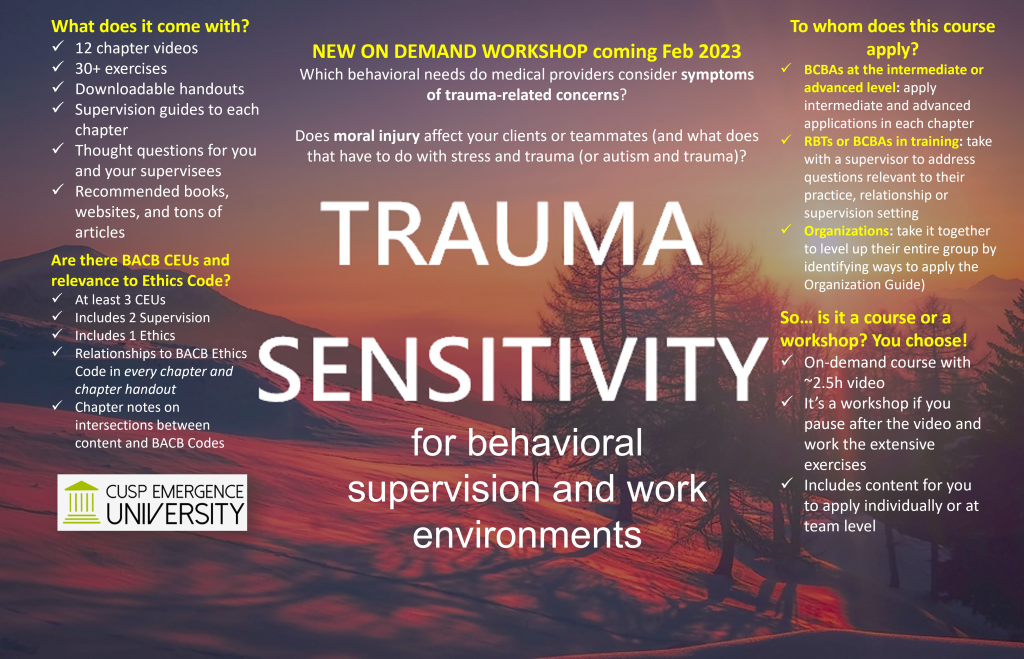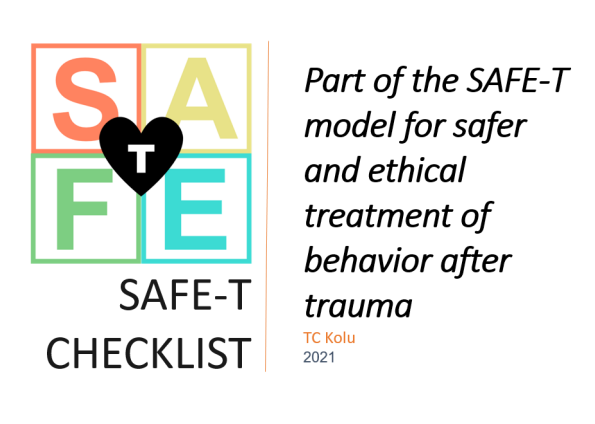(Part 14 of a series of posts about Trauma-informed behavior analysis by Dr. Teresa Camille Kolu, Ph.D., BCBA-D)
Connections between mental health and behavior analysis 
This topic is always close to my heart as I work regularly in mental institutions, and as my business supports wellness practices that affect everyone—including those of us who need help prioritizing our own mental health. But it’s an especially important topic right now: May is Mental Health Month!
Sometimes my work involves conducting an assessment to see whether a client needs behavior analysis, or mental health support, including ways to thrive with a history that includes mental illness. In other words, sometimes (many times!) directly providing mental health support goes beyond my scope, and my job in those cases involves referring to other providers or more typically, collaborating with them. But instead of those cases, today we discuss some intersections between behavior analysis and mental health. If you’re board certified or licensed you’ll want to keep a copy of your field’s ethics code handy (here’s mine, as a BCBA-D). If you’re a family or team member wondering about these connections, read on.
No matter your certification, it’s never ethical to work completely out of one’s boundaries of competence. However, it’s also true that applied behavior analysis has supported individuals with mental illness concerns (including those with symptoms of challenges such as schizophrenia) since the field’s very beginnings. Young BCBAs without historical education in the full range of our field’s applications might have been surprised to see the transformation on some 1950’s psych wards of a population with various psychiatric disorders as patients changed from non-social and despondent individuals to interacting with their peers and their behavior analysts. They met goals they set for starting to take care of themselves again as they got dressed, talked more with peers, worked, visited families, and traded in tokens they earned for individual items they wanted to earn, such as a radio to keep in their room. In the earliest days of applied behavior analysis, Ogden Lindsley and colleagues used reinforcement schedules and behavioral apparatus to analyze psychotic behavior and to reveal that it was subject to operant mechanisms just like other behavior. Behavioral treatment of schizophrenia, in that area, became robust, effective, and almost commonplace. For example, Kurt Salzinger analyzed the verbal behavior of persons with schizophrenia and showed that it was related to discriminative stimuli and consequences of people around the patients (Salzinger and Pisoni, 1958, 1961). A later literature review of articles between 1959 and 1972 (Stahl and Leitenberg, 1976) showed that across 23 articles describing programs for psychotic and chronic mental patients, the individualized behavior programs were widely and substantially effective, producing large improvements in the behaviors that were targeted. History students might enjoy Stephen Wong’s “Behavior Analysis of Psychotic Disorders: Scientific dead end or casualty of the mental health political economy?” (Wong, 2006).
But don’t forget the important caution I mentioned while beginning this section: Without training and expertise and supervision in a given population, any work, no matter your field’s history, is still out of one’s scope. Even so, for those behavior analysts with a more limited history, there are still the vast literatures on the empowering use of self-management to change addictive behavior, manage anxiety, self-monitor triggering situations and select and strengthen one’s own coping skills. These are widely used and well researched. In fact, before there was ACT (or Acceptance and Commitment Therapy), there was self-management. (For a good introductory text on behavioral self management see Alexandra Logue’s Self Control: Waiting Until Tomorrow for What You Want Today). Wherever social contingencies matter, behavior analysis can generally help.
Although using behavior analysis in mental institutions generally fell out of favor decades ago, it has been markedly effective in my last few years of work helping others with mental illness learn skills needed to transition to meaningful lives outside the institution, sometimes after decades in those facilities (or years in group homes, foster homes, and inpatient units). Here, the behavior analytic skills of systems support and functional assessment have been useful for teaching teams how to support individuals who had nearly given up on finding a more permanent home.
Collaboration with providers
What someone needs most and first is sometimes collaboration and support, not an intensive 1:1 ABA session. For my clients with mental illness or mental health needs, it has been extremely helpful to:
-get the entire team on the same page
-look at what has been going wrong (e.g., review incident reports and challenges that have repeatedly plagued the attempts to help the person)
-discover what the team wants
-find out what has been a recurring problem? What is keeping the client from the life they want? Who cares about the client and what skills are missing?
-establish communication protocols for the team
-find out what behavioral and other strategies were already in place and whether or how they are working (Often, a team has been using a token system, or behavior plans, or consequences, or attempts to change behavior using antecedents or instructions and modifying motivation, before a behavior analyst ever entered the picture. Our job is to document what has been done and how this has worked; along the way we can often help an entire agency understand how to make their routine interventions more ethical and effective.)
When I have gathered all of that information plus interviewed team members and my client, documented my review of reports, other supports, and the contributions of medical, historical and childhood factors and the client’s and team goals, I have the makings of a behavior assessment and am able to begin sharing recommendations with the team. These recommendations may include more appropriate and consistent strategies, additional documentation of risks to the client and their community, and training on treatments and ways of interacting that may be more effective and helpful to the team and client than what has been attempted in the past.
Stop for a minute: does all of this suggest that a client is necessarily out of a behavior analyst’s scope of service because they struggle with mental illness? No; furthermore, nothing suggested here discounts the important roles of mental health counselors, psychiatric nurses, social workers, psychiatrists and psychologists, and the other members of the treatment team. If anything, my past several years of work has taught me that a good collaboration has usually resulted in making their roles work even better.
Another way behavior analysis is involved in mental health is the important need to protect our own mental health.
In our line of work, we must be able to respond compassionately and calmly to burned-out staff or clients whose behavior “targets” us, perhaps physically, emotionally, or all of the ways a staff person can be targeted or hurt in the line of work. A recent and excellent training on ACT for intellectual disability shared studies in which it helped reduce staff burnout and increase engagement with clients. These two are related, for when I am healthy and calm I can respond more appropriately and consistently to my clients. Since my clients are often staff, it also helps when I train them in techniques that will help them maintain consistency and calm when they are confronted with the daily grind of their own jobs.
One of the simplest yet most effective interventions is arranging an enriched environment—it grows neurons, increases social behavior, and supports virtually every population. Although it can take less time than waiting and intervening in crises, it is not something an inpatient staff can or wants to do when burned out.
When I teach staff how to stay calm and respond calmly and with preventative input (e.g., my preventative schedule or NCR approach), this is often a burnout-protective approach. It IS behavior analytic, but it’s not complicated.
Connections no one planned
Mental health and ABA are also connected accidentally, when a mental health therapist learns their client is receiving ABA, or a behavior analyst learns their client has also been diagnosed (e.g., anxiety, bipolar disorder, PTSD, or others). In these moments we are forced to look at the connection: what do we do to support the client? Ethically, perhaps we should reach out to learn how the family feels about collaboration; maybe the psychiatric team would love to hear how we are supporting behavior change at home or school and how the data change when medications are changed; or maybe there are important risks to document, or helpful suggestions to make that would help the team stay on the same page. Yet often one or more parties says “not my role!” and makes no efforts to implement connected support. Notice again this is still not suggesting to go outside your role, but to work more collaboratively with others as much as it is appropriate (e.g., Ethics Code 2.03a-b).
Taking care of myself
Finally, here are some other simple behavior analytic strategies that help me manage and protect my own mental health so I stay focused and available to bring my best self to client interaction.
Manage my schedules of reinforcement
I carve out time for myself daily- I make time for tea, breakfast and stretching- all important preventative appetitive things I need to approach regularly.
Set up and honor stimulus control strategies to decrease my exposure to stressors
-Take off email notifications on my phone: Sure, you don’t have to answer them, but how many times has one subject line told you about an upcoming stressor, increased your heart rate, or interrupted your use of coping skills or important family time?
-Limit checking email to when you are prepared to respond (not necessarily by hitting reply, but read it and respond by writing a note you’ll save and send later, perhaps). (If scrolling through my account before bed I notice an inflammatory email, I can pause and return tomorrow. I recently practiced this—stopped reading past the subject line until the morning, and first meditated and had breakfast. It was still upsetting but I found that I was able to answer it and move along).
How do you think behavior analysis and mental health are connected? We love to hear your input, stories or questions.
Selected references and resources
Anthony Biglan, Georgia L. Layton, Laura Backen Jones, Martin Hankins and Julie C. Rusby, The Value of Workshops on Psychological Flexibility for Early Childhood Special Education Staff, Topics in Early Childhood Special Education, 32, 4, (196), (2013).
Lindsley, O. R. (1960). Characteristics of the behavior of chronic psychotics as revealed by free operant conditioning methods. Diseases of the Nervous System (Monograph Supplement), 21, 66-78.
Lindsley, O. R., & Skinner, B. F. (1954). A method for the experimental analysis of the behavior of psychotic patients. American Psychologist, 9, 419-420.
Salzinger, K., & Pisoni, S. (1961). Some parameters of verbal affect responses in schizophrenic subjects. Journal of Abnormal and Social Psychology, 63(3), 511-516.
Salzinger, K., & Pisoni, S. (1958). Reinforcement of affect responses of schizophrenics during the clinical interview. Journal of Abnormal and Social Psychology, 57(1), 84-90.
Stahl, J. R., & Leitenberg, H. (1976). Behavioral treatment of the chronic mental hospital patient. In H. Leitenberg (Ed.), Handbook of behavior modification and therapy (pp. 211-241). Englewood Cliffs, NJ: Prentice-Hall.
Stephen Wong (2006). Behavior analysis of psychotic disorders: Scientific dead end or casualty of the mental health political economy? Behavior and Social Issues, 15, 152-177.








 a
a